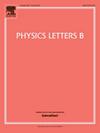(Quasi-)normal modes of rotating black holes and new solitons in Einstein-Gauss-Bonnet
IF 4.3
2区 物理与天体物理
Q1 ASTRONOMY & ASTROPHYSICS
引用次数: 0
Abstract
In this paper, we analyze the scalar field (quasi-)normal modes of recently derived rotating black holes within the framework of Einstein-Gauss-Bonnet theory at the Chern-Simons point in five dimensions. We also examine the mode spectrum of these probes on new static gravitational solitons. These solitons, featuring a regular center, are constructed from static black holes with gravitational hair via a double analytic continuation. By imposing ingoing boundary conditions at the horizons of rotating black holes, ensuring regularity at the soliton centers, and imposing Dirichlet boundary conditions at infinity, we obtain numerical spectra for the rotating black holes and solitons. For static black holes, we demonstrate analytically that the imaginary part of the mode frequencies is negative. Our analysis of the massless Klein-Gordon equation on five-dimensional geometries reveals an infinite family of gapped, massive three-dimensional Klein-Gordon fields, despite the presence of a non-compact extended direction. For the static solitons, the frequencies are real and non-equispaced, whereas in the rotating black holes, counter-rotating modes are absorbed more quickly, and the imaginary part of the co-rotating modes approaches zero as extremality is approached. Additionally, we show that both the rotating black holes and solitons can be equipped with non-trivial torsion, leading to a novel branch of solutions.
求助全文
约1分钟内获得全文
求助全文
来源期刊

Physics Letters B
物理-物理:综合
CiteScore
9.10
自引率
6.80%
发文量
647
审稿时长
3 months
期刊介绍:
Physics Letters B ensures the rapid publication of important new results in particle physics, nuclear physics and cosmology. Specialized editors are responsible for contributions in experimental nuclear physics, theoretical nuclear physics, experimental high-energy physics, theoretical high-energy physics, and astrophysics.
 求助内容:
求助内容: 应助结果提醒方式:
应助结果提醒方式:


